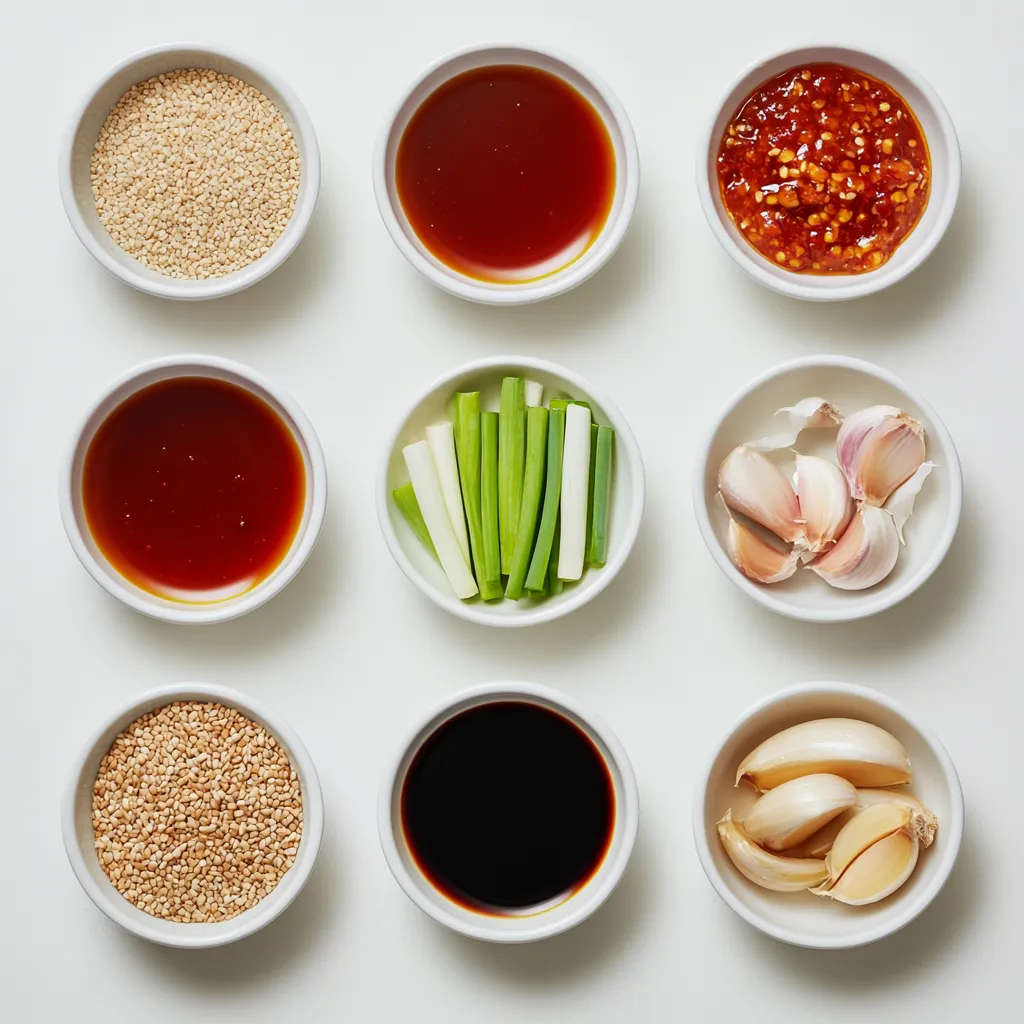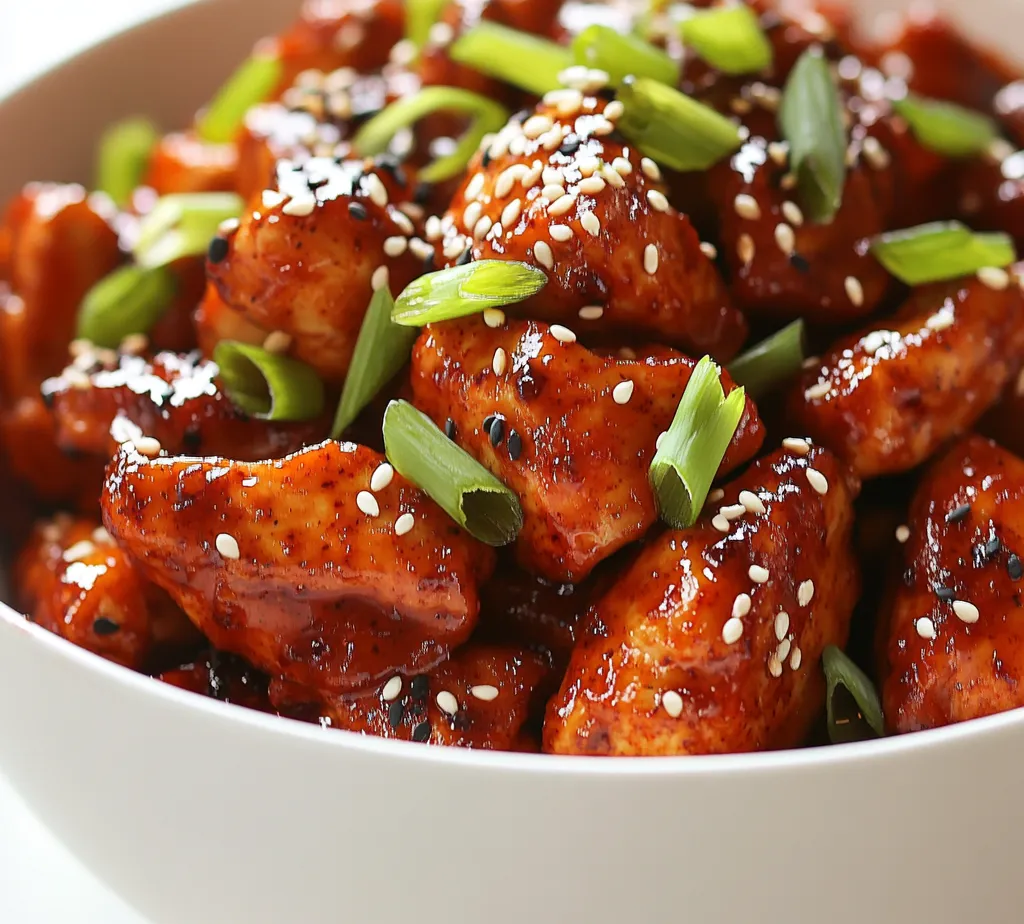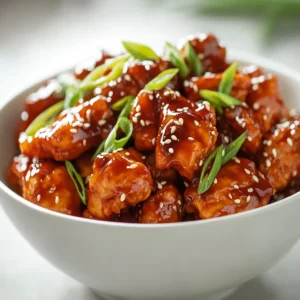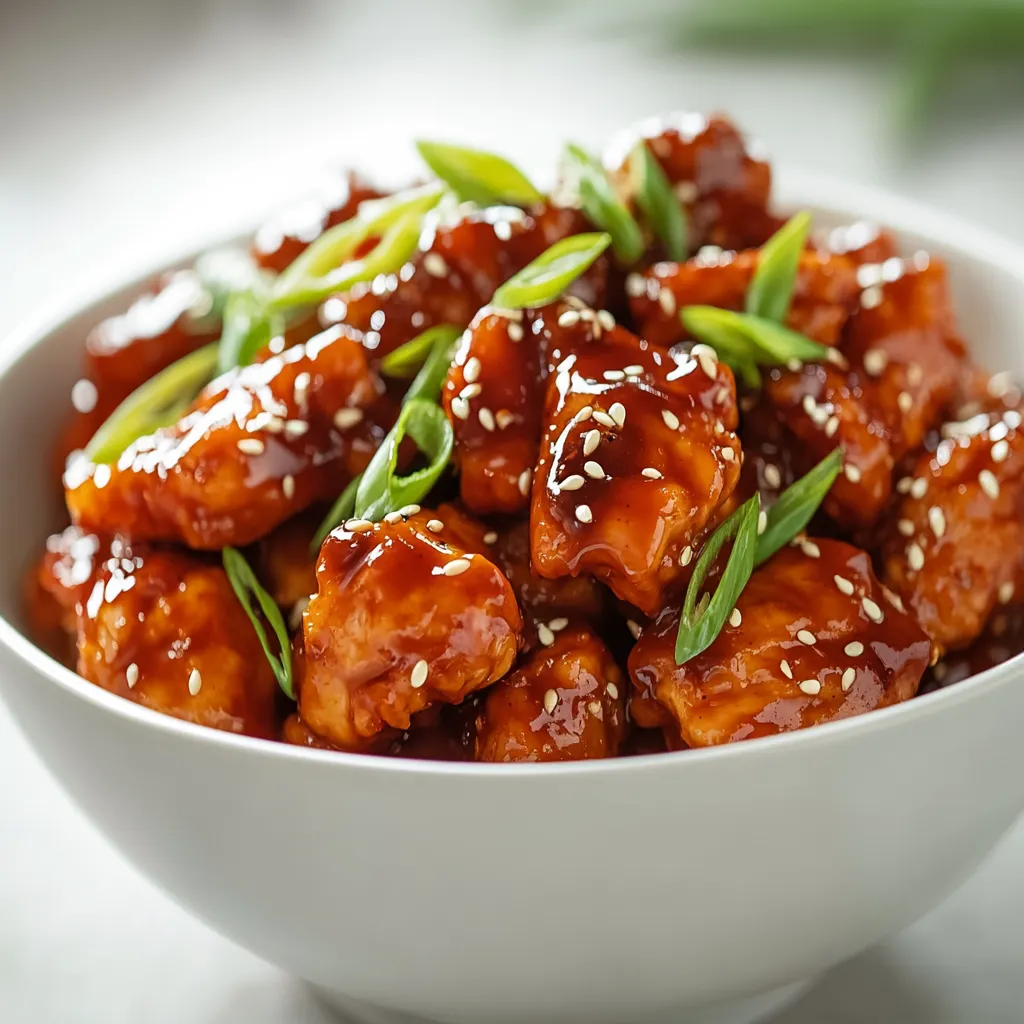Introduction
Gochujang is a staple in Korean cuisine that has gained immense popularity around the world. This Korean red chili paste is known for its unique combination of heat, sweetness, and umami, making it a versatile ingredient in various dishes. The flavor profile of gochujang is complex, with a rich blend of fermented soybeans, glutinous rice, and red chili powder, which all contribute to its deep, layered taste. Whether you’re whipping up a quick weeknight meal or planning a festive dinner, gochujang can elevate your cooking to new heights.
The Fiery Gochujang Chicken Delight is an embodiment of these vibrant flavors. This dish combines spicy, savory, and sweet elements into a mouthwatering meal that tantalizes the taste buds. The star of the recipe is boneless, skinless chicken thighs, which are favored for their tender texture and enhanced flavor when marinated. The combination of gochujang, soy sauce, honey or maple syrup, and other aromatic ingredients results in a dish that’s not only satisfying but also packed with a delightful kick. Perfect for serving at gatherings or enjoying a cozy dinner at home, this chicken dish is sure to impress.
For those who appreciate a bit of heat in their cooking, the Fiery Gochujang Chicken Delight is a recipe that stands out. It’s easy to prepare, yet the flavors are anything but simple. Whether you pair it with fluffy white rice, stirring it into a stir-fried medley of vegetables, or serve it alongside your favorite side dishes, this recipe is bound to become a favorite in your household.
Recipe Overview
– Total Time: 50 minutes
– Prep Time: 10 minutes
– Cook Time: 40 minutes (including marination)
– Yield/Servings: 4 servings
– Difficulty: Not specified in the recipe
Ingredients
– 1 lb (450g) boneless, skinless chicken thighs
– 3 tablespoons gochujang (Korean red chili paste)
– 2 tablespoons soy sauce
– 1 tablespoon honey or maple syrup
– 1 tablespoon sesame oil
– 3 cloves garlic, finely minced
– 1 teaspoon fresh ginger, finely grated
– 1 tablespoon rice vinegar
– 1 tablespoon vegetable oil
– 1 teaspoon sesame seeds (for garnish)
– 2 green onions, thinly sliced (for garnish)
– Salt and pepper to taste
The use of boneless, skinless chicken thighs is essential in this recipe, as this cut of meat is known for its rich flavor and tenderness. Unlike chicken breasts, which can dry out during cooking, thighs hold onto moisture well, ensuring that each bite is juicy and satisfying.
The gochujang plays a pivotal role in this dish. Its piquant flavor paired with sweetness is well balanced by the soy sauce, which enhances the umami notes and contributes to a deeper taste profile. Depending on your heat tolerance, the level of spiciness can be adjusted, offering flexibility while preparing this dish.
The addition of honey or maple syrup not only acts as a sweetener but also balances the spice from the gochujang, creating a harmonious flavor experience. Sesame oil adds richness and aroma, while garlic and ginger introduce fresh, zesty notes that lift the entire dish. Rice vinegar provides acidity, balancing the flavors beautifully, while vegetable oil is the cooking medium that ensures perfect searing of the chicken.
Finally, the sesame seeds and chopped green onions not only serve as a garnish but also introduce interesting textures and additional flavors that complement the gochujang chicken. Salt and pepper round out the seasoning to ensure every element harmoniously blends in each bite.

Instructions
1. Marinate the Chicken: In a large mixing bowl, whisk together the gochujang, soy sauce, honey or maple syrup, sesame oil, minced garlic, grated ginger, rice vinegar, and a pinch of salt and pepper until well combined. Add the chicken thighs, ensuring they are thoroughly coated in the marinade. Cover the bowl with plastic wrap and refrigerate for at least 30 minutes; for maximum flavor, marinate overnight.
2. Cook the Chicken: Heat the vegetable oil in a large skillet over medium-high heat. Once the oil is shimmering, carefully add the marinated chicken thighs to the skillet. Sear the chicken for about 6-7 minutes on each side, or until it is fully cooked and exhibits a beautiful caramelized crust. To ensure doneness, check that the internal temperature reaches 165°F (75°C) using a meat thermometer.
3. Glaze and Reduce: After cooking the chicken, transfer it to a plate and set aside. In the same skillet, pour in the leftover marinade and bring it to a gentle simmer. Allow it to cook for 3-4 minutes until it thickens slightly, creating a luscious glaze.
4. Combine: Return the chicken to the skillet and toss it in the thickened sauce, ensuring each piece is well-coated. Cook for an additional 1-2 minutes, allowing the flavors to meld beautifully.
5. Serve: Arrange the fiery gochujang chicken on a serving platter. Sprinkle with sesame seeds and garnish with the sliced green onions for a fresh touch. Serve hot alongside steamed rice or your choice of favorite side dishes for a complete meal.
The marination process is not just about flavor; it also greatly impacts the tenderness of the chicken. As it absorbs the marinade, the meat becomes more succulent, infusing every bite with the essence of gochujang and supporting ingredients. The searing technique employed when cooking the chicken is vital for achieving that desirable caramelized crust, enhancing the overall taste of the dish.
Marinating the Chicken
Marinating chicken is a fundamental cooking technique that can transform a simple protein into an extraordinary culinary experience. For the Fiery Gochujang Chicken Delight, marinating is essential for both flavor penetration and tenderness. The marinade composed of gochujang, soy sauce, honey or maple syrup, sesame oil, minced garlic, grated ginger, and rice vinegar plays a critical role in taste enhancement.
To prepare the marinade, simply combine all the listed ingredients in a large mixing bowl and whisk until smoothly blended. The vibrant color of the gochujang will be beautifully contrasted with the lighter tones of the soy sauce and vinegar. When the chicken thighs are thoroughly coated with this mixture, the ingredients begin to work their magic, infusing the meat with deep flavors.
For optimal results, it’s best to let the chicken marinate for at least 30 minutes, though marinating overnight will yield even more pronounced flavors. As the chicken soaks, the acids in the marinade help to tenderize the meat, resulting in a succulent dish that promises to satisfy any palate. Consider that the longer the marination, the more intense the flavor, making this simple step a crucial part of the recipe.
Cooking Techniques
The cooking technique used in this recipe revolves around skillet cooking, which allows for both quick preparation and amazing results. Skillet cooking is a popular method because it captures the flavors beautifully while creating a delightful surface upon the meat. In the case of the Fiery Gochujang Chicken Delight, searing the chicken thighs in hot vegetable oil is essential.
Before cooking, preheat the skillet and add the vegetable oil, ensuring it reaches a shimmering effect—not too hot to smoke, but hot enough to create a beautiful caramelized crust on the chicken. This caramelization enhances the natural flavors of the chicken and adds a touch of depth to the overall taste profile.
Once the oil is ready, carefully add the marinated chicken thighs to the skillet, taking precaution to avoid splatters. Sear them for about 6-7 minutes on each side, controlling the heat to prevent burning. To check for doneness without cutting into the chicken, use a meat thermometer to ensure the internal temperature reaches 165°F (75°C).
This method of cooking combined with the flavors of the marinade and the perfect timing will yield beautifully seared chicken that is both flavorful and tender, ready to embrace the luscious glaze that follows in the cooking process.

Checking for the Internal Temperature
To ensure the chicken is cooked thoroughly and safely, it’s essential to monitor its internal temperature. Cooking chicken to the correct temperature not only guarantees its safety by killing any harmful bacteria, but it also significantly affects the texture and juiciness of the meat. The recommended internal temperature for fully cooked chicken thighs is 165°F (75°C).
Tools Needed for Checking Temperature
A reliable meat thermometer is indispensable when cooking chicken. Digital instant-read thermometers are ideal as they provide quick, accurate readings. Insert the thermometer into the thickest part of the thigh, avoiding bone, for the most accurate result. Always clean the thermometer after use to maintain good hygiene standards.
Signs of Well-Cooked Chicken Thighs
In addition to using a thermometer, there are visual signs to identify well-cooked chicken thighs. The meat should be opaque and not have any traces of pink. The juices should run clear when pierced. Furthermore, a beautifully caramelized crust signifies a proper sear and flavor development.
Making the Sauce
The Importance of Glazing the Chicken in Leftover Marinade
Glazing the chicken in the leftover marinade transforms the dish, allowing the flavors to intensify and meld beautifully with the meat. This step enhances moisture, taste, and creates a cohesive sauce that showcases your ingredients. Since the chicken has absorbed some flavors during marination, returning it to the sauce creates a robust and harmonious taste experience.
Steps to Simmer and Thicken the Sauce
To thicken the marinade, pour the leftover marinade into the same skillet used to cook the chicken. Bring it to a gentle simmer over medium heat and allow it to reduce for about 3-4 minutes. This reduction process concentrates the flavors and improves the overall texture, making it ideal for coating the chicken.
Importance of Reducing the Marinade for Flavor Enhancement
Reducing the sauce is crucial because it allows complex flavor compounds to develop fully. As the mixture simmers, water evaporates, intensifying the remaining flavors. This technique ensures a thicker, more concentrated sauce that clings elegantly to the chicken, creating a sensational taste experience with each bite.
Combining Flavors
Techniques for Incorporating Chicken Back into the Sauce
When bringing the chicken back into the thickened sauce, use tongs or a spatula to gently toss the chicken until all pieces are evenly coated. Avoid using excessive force, as this can break the chicken apart, affecting the final presentation.
The Role of Additional Cooking Time for Flavor Melding
The brief additional cooking time of 1-2 minutes in the sauce is essential for allowing the flavors to meld together. During this period, the chicken absorbs more of the concentrated marinade, resulting in a rich flavor profile that enhances each bite.
Importance of Even Coating in the Glaze
Even coating ensures every piece of chicken is fully enveloped in the flavor-rich glaze. It not only improves the taste but also adds visual appeal. To achieve this, periodically toss the chicken gently in the pan, ensuring each piece is well-coated.
Serving Suggestions
Approaches for Presenting the Dish
When presenting the fiery gochujang chicken, consider serving the chicken in a shallow dish layered with rice or other grains. This not only allows the sauce to soak into the sides but also provides a beautiful backdrop for the vibrant, caramelized chicken.
Serving Tips with Rice and Garnishes
Pair the dish with fluffy white rice as it balances the heat from the spices. Garnishing with sesame seeds and sliced green onions adds contrast and a fresh element to the dish. Drizzling extra sauce over both the chicken and rice makes for a visually appealing and flavor-packed presentation.
Ideas for Side Dishes That Complement the Flavors
Serve the chicken alongside simple side dishes that contrast with its spiciness. Options like cucumber salad, pickled radishes, or steamed broccoli provide refreshing notes that can effectively cut through the heat. Moreover, Korean sides like kimchi or seasoned spinach (sigeumchi namul) can enhance the meal’s authenticity.
Optional Serving Styles for Variety
For a delightful twist, consider serving the chicken in lettuce wraps with rice and a dollop of sauce for a fun, hands-on meal. Alternatively, using the dish as a filling for tacos or wraps offers an exciting fusion approach that combines cultural elements and makes for playful dining.
Presentation Tips
Tips for an Appealing Visual Display
An attractive presentation can elevate any dish. For fiery gochujang chicken, arrange the chicken pieces artfully scattered over white rice, creating a colorful contrast. Drizzle with sauce and sprinkle with sesame seeds for added texture.
Suggestions for Incorporating Colors and Textures
Incorporating different colors and textures can enhance the dining experience. Accompanying the chicken with bright green vegetables or vibrant pickles not only makes the plate visually appealing but also adds delightful crunch and freshness to balance the savory flavors of the dish.
How to Elevate the Dining Experience with Simple Additions
Transform a simple meal into a culinary experience by serving the dish with traditional Korean sides like banchan (small side dishes). Including a small bowl of steaming miso soup or herbal tea can further enhance the meal and create a comforting atmosphere.
Pairing Beverages
Recommended Drinks That Pair Well with Spicy Dishes
Spicy dishes like fiery gochujang chicken pair well with refreshing beverages that can mitigate the heat. Crisp beers or light lagers complement the spices while enhancing the overall dining experience. Seltzers infused with citrus flavors are another refreshing option that can cool the palate.
Suggestions for Both Alcoholic and Non-Alcoholic Options
For non-alcoholic options, consider offering iced green tea or a sparkling water with lemon to refresh and cleanse the palate. Both options contribute to an enjoyable dining experience without overwhelming the dish’s flavors.
Mention of Traditional Korean Beverages That Suit the Meal
If you wish to embrace traditional flavors, serve the chicken with makkoli, a Korean rice wine that balances spices with its mild sweetness. Alternatively, soju, a popular Korean spirit, can also enhance the meal and provide a delightful pairing with the fiery flavors.
Nutritional Information
Overview of the Dish’s Nutritional Profile
The fiery gochujang chicken provides a blend of protein and essential nutrients due to its ingredients. The chicken thighs offer a rich source of protein, while the gochujang sauce contributes beneficial health properties from its fermented ingredients.
Insights into Calories Per Serving and Main Nutrients
Each serving of this dish contains approximately 350-400 calories, depending on the specific cooking method and additional ingredients used. Key nutrients include protein, healthy fats from sesame oil, and vitamins and minerals found in garlic, ginger, and green onions.
Discussion of Health Benefits of Key Ingredients
Gochujang contains capsaicin, which may provide metabolic benefits, and ginger and garlic are known for their anti-inflammatory properties. Incorporating such ingredients into meals can enhance overall well-being while delivering flavor.
Conclusion
The fiery gochujang chicken offers a delightful combination of spiciness, sweetness, and savory depth, resulting in a tender and flavorful dish. With a preparation time of just 10 minutes and a total of 50 minutes to dinner, it is an accessible recipe that impresses in both taste and presentation. Whether served on rice or enjoyed with fresh sides, this dish creates a satisfying meal experience for spicy food enthusiasts.

Fiery Gochujang Chicken Delight Recipe
Ingredients
- 1 lb boneless skinless chicken thighs
- 3 tablespoons gochujang
- 2 tablespoons soy sauce
- 1 tablespoon honey or maple syrup
- 1 tablespoon sesame oil
- 3 cloves garlic finely minced
- 1 teaspoon fresh ginger finely grated
- 1 tablespoon rice vinegar
- 1 tablespoon vegetable oil
- 1 teaspoon sesame seeds for garnish
- 2 green onions thinly sliced (for garnish)
- Salt and pepper to taste
Instructions
- In a large bowl, whisk together gochujang, soy sauce, honey or maple syrup, sesame oil, garlic, ginger, rice vinegar, salt, and pepper.
- Add chicken thighs to the marinade, ensuring they are well coated. Cover and refrigerate for at least 30 minutes or overnight.
- Heat vegetable oil in a skillet over medium-high heat. Add marinated chicken thighs and sear for 6-7 minutes on each side until fully cooked.
- Transfer chicken to a plate and set aside. Pour leftover marinade into the skillet and bring to a simmer.
- Cook the marinade for 3-4 minutes until it thickens slightly.
- Return the chicken to the skillet and toss in the thickened sauce for 1-2 minutes.
- Arrange the chicken on a serving platter and sprinkle with sesame seeds and green onions.
- Serve hot with steamed rice or your choice of side dishes.

